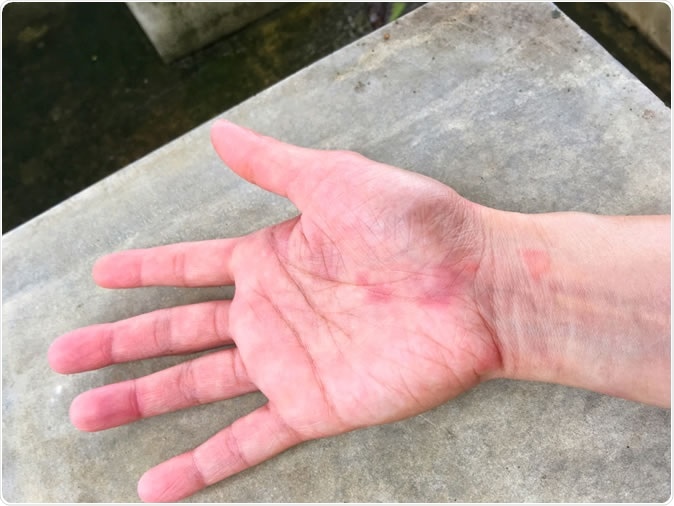Researchers have found that alteration in the environment and atomospheric factors could be associated with organ specific flare-ups of lupus among patients diagnosed with Systemic Lupus Erythematosus (SLE). The study results were presented at the 2019 ACR/ARP Annual Meeting. The abstract was titled, “Environmental and Atmospheric Factors in Systemic Lupus Erythematosus: A Regression Analysis.”
The researchers explained that SLE is a chronic condition that leads to inflammation which may affect various organs within the body including skin and the joints. Kidneys, lungs and even the brain and the heart can be affected by SLE. Non-specific symptoms including fever, fatigue or lethargy, weight loss etc. are common features of the conditions. This study reveals that environmental factors could play a role in the ups-and downs associated with this disease. Knowledge of these factors could also help physicians and rheumatologists warn their patients accordingly and take necessary management steps say the researchers.

Sun exposure can lead to lupus flares. Involvement of the kidneys or/and the brain is the most serious manifestation of lupus. Lupus occurs ten times more often in women than in men. Image Credit: Korn Ratchaneekorn / Shutterstock
For this study the team looked at the effects of fine particulate matter (PM2.5) concentration, temperature, relative humidity, resultant winds, ozone concentration and barometric pressure on the flare ups associated with different organs among patients with SLE.
Lead author, George Stojan, MD, Assistant Professor of Medicine, Johns Hopkins Lupus Center, in a statement said that in the recent study they have found that there are 40 known single nucleotide polymorphisms or SNPs that are important in causing lupus. These however occur in a very small proportion of individuals and thus environmental factors could be directly related to lupus flare-ups. Stojan said, “There is strong epidemiologic evidence of association with several environmental factors, including crystalline silica exposure, cigarette smoking, and exogenous estrogens as well as potential associations between other exogenous factors such as mercury, ultraviolet radiation, solvents and pesticides.”
Stojan added, “When it comes to atmospheric impact, data from the Hopkins Lupus Center previously described significant seasonal variation in SLE disease activity with more arthritis activity in the spring and summer months, and an increase in renal activity in winter months, significantly higher anti-dsDNA antibody titers in the fall, and a significant variation of global disease activity through the year. While several studies in the past attempted to correlate global SLE disease activity with atmospheric changes, this is the first study looking at the association of organ specific lupus flares with atmospheric changes prior to patient visits.”
For this study the team of researchers included 1,628 patients. These patients had at least four of the eleven ACR or SLICC classification criteria for SLE and thus were confirmed with the diagnosis of SLE. These patients were followed up between 1999 and 2017. At each of the visits to the physician the disease level was measured using the Physician Global Assessment (PGA). If the PGA score rose by one point compared to the previous visit, it was considered to be a lupus flare wrote the researchers. The U.S. Environmental Protection Agency (EPA) data was used for the environmental data wrote the researchers. They calculated the average values of the environmental parameters for each of the patients ten days prior to their doctor’s visit. Other factors such as age of the patient, gender, socio economic status, racial and ethnic groups and urban or rural residence were taken into account before association between environmental change and SLE could be computed. These factors acted as confounding factors wrote the researchers.
Results revealed that there was a significant association between environmental changes and lupus flare-ups. For example with rise in temperature there seemed to be a flare up of lupus skin rash, serositis, joint flares and blood disorders. As temperatures and ozone levels rose, there was a decrease in flares of kidney disease. Residual wind changes were associated with lungs, kidney, brain, blood and joint flare-ups. As the PM2.5 concentration rose, there were more complains of rash, joint problems, serositis and blood disorders among the SLE patients. Humidity too was associated with serositis, joint problems etc. None of the environmental factors however affected all the various symptoms of SLE, wrote the researchers.
Dr. Stojan said, “These findings raise concern for a potentially significant impact of atmospheric changes on the occurrence of organ-specific lupus flares, but further studies are necessary to confirm this effect and to potentially explain it. Atmospheric effects may have an important impact on lupus clinical trial design and outcomes.” He concluded, “From a global perspective, these findings could implicate climate change and global warming as important factors in the rapidly changing epidemiology of lupus worldwide. Ultimately, these findings are the first step to vindicating the great majority of lupus patients who are convinced that their disease is influenced by weather changes and who inspired this research.”
Authors of the study wrote in conclusion, “These data could add an important aspect to lupus trials, the outcomes of which may be affected by so far unrecognized environmental factors, and ultimately it could allow predictive modelling of lupus flares which would revolutionize the approach to treatment.”
Journal reference:
Stojan G, Curriero F, Kvit A, Petri M. Environmental and Atmospheric Factors in Systemic Lupus Erythematosus: A Regression Analysis [abstract]. Arthritis Rheumatol. 2019; 71 (suppl 10). https://acrabstracts.org/abstract/environmental-and-atmospheric-factors-in-systemic-lupus-erythematosus-a-regression-analysis/. Accessed November 11, 2019. https://acrabstracts.org/abstract/environmental-and-atmospheric-factors-in-systemic-lupus-erythematosus-a-regression-analysis/